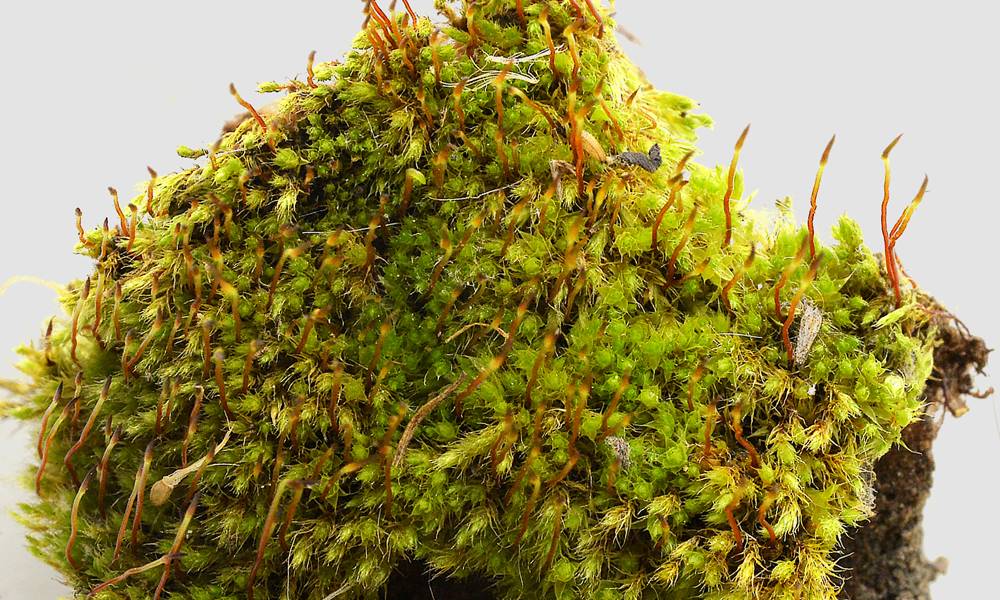
Consortium of Bryophyte Herbaria
- building a Consortium of Bryophytes and Lichens as keystones of cryptobiotic communities -
|
Family: Bryaceae |
Plants: small to very large, in dense or open turfs, red, pink, yellow-green, or brown-green. Stems: 0.5–4(–12) cm, tufted, comose or evenly foliate, freely branching by subfloral innovations; rhizoids few to many, micronemata and macronemata present. Leaves: weakly to strongly contorted or shrunken when dry, erect to erect-spreading when moist, ovate, ovate-lanceolate, or orbicular, flat to concave, (0.5–)1–4(–5) mm; base decurrent or not; margins plane or revolute, entire to denticulate distally, 1- or 2-stratose, limbidium usually present; apex obtuse to acuminate; costa usually percurrent to long-excurrent, awn smooth or denticulate, guide cells usually present in 1 layer; alar cells not differentiated; laminal areolation heterogeneous; proximal laminal cells gradually short- to long-rectangular, usually longer than more distal cells, 2–4:1; medial and distal cells rhomboidal to hexagonal, usually 2–4:1, walls thin to very incrassate, porose or not. : Specialized asexual reproduction rare, by filiform gemmae in stem leaf axils and on rhizoids. Sexual: condition dioicous, synoicous, autoicous, or polyoicous; perigonia and perichaetia terminal; perigonial and perichaetial leaves somewhat differentiated, outer leaves somewhat enlarged and more acuminate, inner leaves smaller, narrowly ovate-lanceolate to triangular. Seta: single, straight to flexuose. Capsule: highly variable, suberect, inclined, or nutant, ovate, obovate, pyriform, clavate, or turbinate, 2–6(–7) mm; hypophysis slender or thick; operculum conic to low-convex, rounded to apiculate; peristome double; exostome yellow, orange, or brown basally, usually hyaline distally, teeth well developed, lanceolate; endostome sometimes adherent to exostome at base, basal membrane high, segments usually well developed, narrowly to broadly perforated, cilia variously short and appendiculate, or absent. Spores: shed singly, size often variable in same collection and capsule, 10–50 µm, smooth to distinctly papillose, yellow, brown, black, or green. Nearly worldwide, mostly in Northern Hemisphere in arctic, boreal and alpine regions, plus the Southern Hemisphere in cold-temperate to subantarctic regions. Species ca. 60 (31 in the flora). Species of Ptychostomum exhibit a primary radiation in the Northern Hemisphere, where they form a maze of polyploid arctic-boreal populations that exhibit high variability and often grade into one another. The plants occur on soil, mud, peat, or less commonly on rock or wood. Many species are distinguished by minor differences in capsule shape, operculum development, and peristome structure. The two main subgenera of Ptychostomum reflect those species with relatively short proximal laminal cells, inflated subalar cells, 1-stratose limbidium, and comose stems (subg. Cladodium), and those with more elongate foliate stems, not particularly comose, with long-rectangular proximal laminal cells, a thin, partially 2-stratose border, and non-inflated subalar cells (subg. Ptychostomum). This treatment does not make use of taxonomic sections since there is considerable confusion over the correct names, with many invalidly published. A. L. Andrews (1935), E. Nyholm (1986+, fasc. 3), A. J. E. Smith (2004), and V. I. Zolotov (2000) provided valuable treatments of most species in the flora area. For many species, mature capsules, spores, and sexual condition are needed for correct determination. |
Powered by Symbiota.





